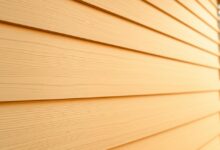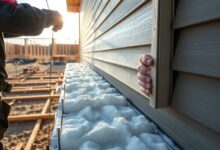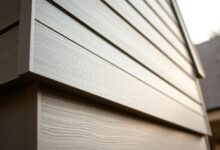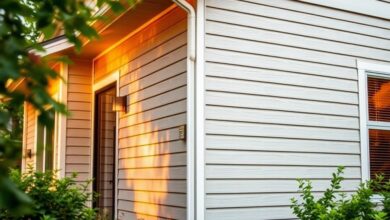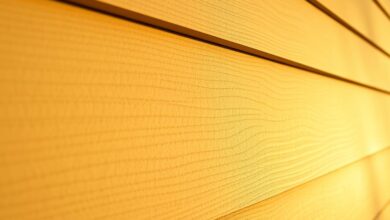Insulated Siding for Noise Reduction: A Tutorial
Creating a peaceful living environment is key for home comfort. Using insulated siding is a great way to cut down on outside noise. Noise pollution can really affect our quality of life, so finding good solutions is important.
This tutorial will show you how to use insulated siding to make your home quieter. You’ll learn about its benefits and how to install it. This way, you can make your living space better.
Key Takeaways
- Understanding the role of insulated siding in noise reduction
- Benefits of using insulated siding for home comfort
- Overview of the tutorial’s content and objectives
- Key considerations for insulated siding installation
- Expected outcomes of implementing insulated siding for noise reduction
Understanding Noise Pollution and Its Impact on Home Comfort
Our homes are facing a new threat: noise pollution. This problem makes our living spaces less comfortable. It’s hard to relax when outside noise keeps interrupting.
Common Sources of External Noise
Many things can make noise outside our homes. This includes
How Noise Affects Quality of Life
Being around noise pollution for too long can harm us. It can cause stress, sleep problems, and lower our quality of life. To keep our homes peaceful, we need to fight this problem. Good soundproofing can help a lot, making our lives better.
What Is Insulated Siding and How It Works
Insulated siding materials help make your home quieter by blocking outside sounds. They use special materials and designs. This not only makes your home more energy efficient but also keeps out noise.
Types of Insulated Siding Materials
There are many types of insulated siding materials. Each has its own benefits and features. These include:
- Foam-backed vinyl siding
- Insulated fiber cement siding
- Expanded polystyrene (EPS) insulated siding
These materials vary in how well they block sound and save energy. Homeowners can pick the best one for their home.
The Science Behind Sound Dampening
Sound dampening works by using materials that soak up sound energy. This reduces the noise that gets into your home. The quality of these materials is shown by their STC ratings.
STC Ratings Explained
STC ratings show how well a material blocks sound. A higher rating means better sound insulation. For instance, a material with an STC rating of 50 is quite good at blocking sound.
| Material | STC Rating |
|---|---|
| Foam-backed vinyl siding | 28-32 |
| Insulated fiber cement siding | 35-40 |
| EPS insulated siding | 40-50 |
Benefits of Insulated Siding for Noise Reduction
Insulated siding brings many benefits, like better noise control, energy savings, and looks. It makes homes quieter and more comfy. Plus, it can cut down on energy bills.
Noise Reduction Capabilities
Its main perk is blocking outside noise. Thanks to high Sound Transmission Class (STC) ratings, it keeps out sounds from traffic and construction.
Energy Efficiency Advantages
It’s also great for saving energy. Insulated siding stops heat from moving in and out. This means lower costs for heating and cooling.
Aesthetic and Property Value Benefits
Insulated siding comes in many styles and colors. It’s easy to match your home’s look. Plus, it can boost your home’s value by making it look better and more energy-efficient.
| Benefits | Description |
|---|---|
| Noise Reduction | Effective in blocking external noise |
| Energy Efficiency | Reduces heat transfer, lowering energy costs |
| Aesthetic Appeal | Available in various styles and colors |
Pre-Installation Planning and Preparation
First, you need to figure out what your home needs to block out noise. This step is key to a good installation.
Assessing Your Home’s Noise Issues
It’s important to find out where the noise is coming from. Do a detailed noise assessment to pick the right siding for your home.
Measuring and Calculating Materials Needed
Getting the right measurements is critical. This helps cut down on waste and make the installation smooth. Figure out how much siding you’ll need and extra for trim and finishing.
Tools and Equipment Checklist
Before you start, make sure you have all the tools and gear. You’ll need siding cutters, drills, and safety equipment.
Safety Considerations
Safety is always first when installing siding. Make sure your workspace is safe. If you’re not sure about something, think about getting professionals.
With good planning and preparation, your insulated siding installation will be a success. It will help you meet your noise reduction goals.
Step-by-Step Installation Guide for Insulated Siding
To get the best noise reduction and energy savings, follow this guide for insulated siding installation. It covers several important steps for a successful and lasting installation.
Removing Existing Siding
The first step is to take off the old siding. This needs to be done carefully to not harm the wall underneath. Use a pry bar and hammer to remove the siding, starting from one corner and moving to the other. Always wear gloves and safety glasses while doing this.
Preparing the Wall Surface
After removing the old siding, check the wall for any damage or rot. Fix any problems before moving on. Clean the wall well to help the new insulated siding stick better. Look for any nails or debris sticking out and fix them.
Installing Insulation Backing
Next, put in the insulation backing as the maker’s instructions say. This step is key for the siding’s energy saving and noise blocking. Make sure the insulation fits right and is securely attached to the wall.
Attaching Insulated Siding Panels
Start putting on the insulated siding panels from the bottom up. Use the right fasteners and follow the maker’s advice for spacing and alignment. Make sure to overlap the panels as needed to keep them tight and watertight.
Finishing Touches and Trim Work
Once the insulated siding panels are on, finish with trim and finishing touches. Put in trim around windows, doors, and corners. Make sure all edges are sealed well to keep the installation strong.
By following these steps, you can get a great insulated siding installation. It will make your home more comfortable, energy-efficient, and look better.
Maintenance and Care for Optimal Noise Reduction Performance
To keep insulated siding working well, regular care is key. This ensures it keeps your home quiet.
Regular Inspection Routine
Checking your siding often is important. Look for cracks, gaps, or wear. Spotting problems early helps avoid bigger issues.
Cleaning and Preserving Your Insulated Siding
Keep your siding clean to keep it looking good and working right. Use mild soap and water. Stay away from harsh chemicals or rough cleaners. Right cleaning can make your siding last longer.
When to Repair or Replace Damaged Sections
If you find damaged siding, fix or replace it fast. Waiting can cause more harm. Get a pro for siding repair to do it right.

Effective Noise Reduction with Insulated Siding
Installing insulated siding is a smart way to cut down on outside noise and make your home more comfortable. It helps you understand why noise is a problem and how insulated siding can help. This way, you can make better choices to improve your living space.
A summary on noise reduction shows how important it is to tackle outside noise. Insulated siding is key in blocking noise, making your home quieter. It also saves energy, making your home more efficient.
By following this guide, you can put in insulated siding and make your home quieter and more cozy. Keeping it in good shape is important to keep it working well for a long time.
Think about getting insulated siding to make your home a peaceful place. It’s good for noise reduction and easy to install. It’s a smart choice for making your home better.
